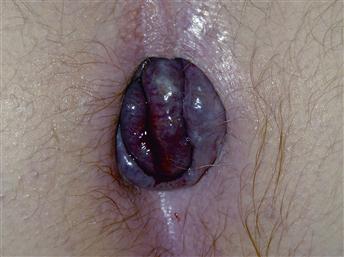Anorectal Pain
Anorectal pain is a common problem. The majority of patients have an obvious cause, e.g. fissure-in-ano, perianal abscess or thrombosed haemorrhoids.
History
Constipation with pain on defecation and blood (usually on the paper) will suggest fissure-in-ano. A sudden onset of pain with a tender lump in the perianal region will suggest perianal haematoma. A past history of prolapsing piles, with failure to reduce them, associated with pain and tenderness suggests thrombosed haemorrhoids. Gradual onset of pain and tenderness with swelling is suggestive of abscess formation. A careful history must be taken of trauma. A history of anal sexual exposure will suggest gonorrhoea or herpes. With gonorrhoea, there may be irritation, itching, discharge and pain. With herpes, there will be pain and irritation. Proctalgia fugax is diagnosed on the history of perineal pain, which is spasmodic, the spasms lasting up to 30 min. The pain often feels deep inside the rectum. The cause is unknown but may be related to paroxysmal contraction of levator ani. Anorectal malignancies will be suggested in alteration of bowel habit and bleeding on defecation. Pain will only be apparent if the tumour involves the anal canal below the dentate line, where sensation is of the somatic type. Solitary rectal ulcer may present with pain but more usually presents with bleeding PR, passage of mucus and difficulty with defecation. Chronic perianal sepsis may be the presenting symptom of Crohn’s disease or TB. These diseases may already be manifest at other sites of the body. Rarely lesions of the cauda equina may cause anal pain.
Examination
Inspection may reveal a chronic fissure-in-ano, perianal haematoma, thrombosed piles or a tumour growing out of the anal canal. A tense, red, tender area may be present, representing a perianal abscess. A fullness in the buttock with redness may indicate a large ischiorectal abscess. A digital rectal examination should be carried out unless the diagnosis is obvious. With gonococcal proctitis, proctoscopy may reveal pus and blood in the rectal ampulla with oedematous and friable mucosa. The presence of vesicles in the anal area will suggest herpes. Solitary rectal ulcer is usually diagnosed on sigmoidoscopy when redness and oedema of the mucosa is seen, usually, but not always, in association with frank ulceration. If a cauda equina lesion is suspected, a full neurological examination should be carried out. No abnormality is usually found with proctalgia fugax.






